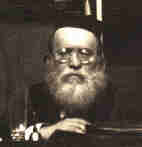 |
Hadrash Ve-Haiyunby the Reisha Rav, HaGoan Rav Aaron Levine TZ"LElucidated and Adapted by Efraim Levine |
 |
Hadrash Ve-Haiyunby the Reisha Rav, HaGoan Rav Aaron Levine TZ"LElucidated and Adapted by Efraim Levine |
5761
Noach
To Dedicate Please Contact Hadrash Ve-Haiyun
Make for yourself an ark of gopher wood, with compartments shall you make the ark and tar it with pitch within and without. (Bereishis 6:14)
In the era of Noach the world was destroyed by the destructive floodwaters. The only place of refuge was the ark. It can likewise be said that during our long gulus the world is flooded with the destructive anti-Torah influences of the secular world. In addition to our synagogues and places of study, the main place where the Jew can find refuge is in his home. However, just as the Torah lays out precise details for the construction of the ark so to, in order for the home to succeed in providing protection it must be constructed with precision. With this idea in mind let us attempt to explore the symbolic characteristics of the ark and apply them to the construction of the home.
“Make yourself an ark of gopher wood.” – From the Gemara (Sanhedrin 108b) and Midrash (Midrash Rabba 30) it is clear that gopher wood is a type of cedar. The Midrash (Bamidbar Rabba 3, Yalkut Tehilim 92) teaches that cedar has two distinct characteristics. First, it is the tallest of all trees and second, it has strong deep roots that prevent the tree from being swayed in any way. The conveyed message is that our home must also be built will the highest values and ideals. The values of the Jewish home must stand paramount to all influences and secular values of society. Likewise these ideals and values must be deeply rooted within the homes, in order to prevent us from being uprooted and swayed in any way whatsoever.
“Make the ark with compartments.” - At times it is necessary to bring into the home a variety of secular materials and influences. However, the home must follow in the example of the ark where everything had its place. Within the ark the people, animals, food and garbage were not deposited together in one large room but rather everything was placed in separate compartments. There was order. Likewise, in the home each item should be placed in its proper compartment. One should not mix what is holy with what is not holy, what is pure with what is not pure, but rather everything must have its place and be set in its proper perspective.
“Tar it with pitch inside and out.” - Just as the ark was protected with a covering of pitch within and without, likewise the values of the Jewish home should be true both inside and out. It is not enough for the Jewish home to promote itself as pure and righteous to the outside world. More importantly, it must live up to the ideals and standards within as well.
“A tzohar shall you make for the ark.” - According to one interpretation the tzohar was a window which allowed light to enter the inside of the ark. The tzohar thus represents the ark’s connection to the outside world. Likewise, a Jewish home should not completely isolate itself, but rather should have some form of media with which it connects itself to the outside world. Through this connection it can relate to the happenings of the world and to Jewish current events. In good times, this home can rejoice in the good fortune of the Jewish people and in hard and difficult times it can join in their pain and suffering.
“An entrance of the ark you shall put in its side.” - The Jewish home should have an entrance that is readily accessible to the community. The community should know that this home is a place where guests are always welcome and is a place that is ready to be used to serve the community.
“Make it with bottom middle and upper floors.” - We may suggest that these three floors represent the three pillars on which the world stands: Torah, Avodah, i.e., prayer and Gemilas Chasadim, i.e. acts of kindness. These three pillars shall be the ideals with the Jewish home represents and strives to perfect.
May it be that through the merit of constructing our homes in the image of the ark we merit to see the fulfillment of the posuk “and Hashem caused a spirit to pass over the earth and the waters subsided,” which we may interpret as: Hashem will bring a spirit of holiness and sanctification over the world and the destructive anti-Torah influences will no longer be.